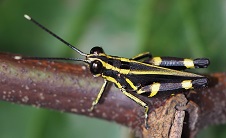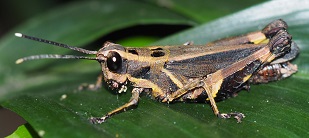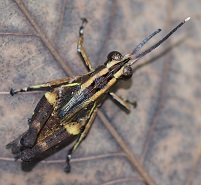| Home | Nature Weekly Index |
21 May 2017 | Black Forest Grasshopper | Traulia azureipennis |

 Traulia azureipennis is commonly known as
the Black Forest Grasshopper. The male is black with yellow stripes while the female is dark-brown and larger in size than
the male. Both sexes have antennae that end with white tip. The most detailed description was available in the 2012
publication titled
“Orthoptera in the Bukit Timah and Central Catchment Nature Reserves”.
The male grasshopper was featured in a $2 Singapore postage stamp in
1985.
Traulia azureipennis is commonly known as
the Black Forest Grasshopper. The male is black with yellow stripes while the female is dark-brown and larger in size than
the male. Both sexes have antennae that end with white tip. The most detailed description was available in the 2012
publication titled
“Orthoptera in the Bukit Timah and Central Catchment Nature Reserves”.
The male grasshopper was featured in a $2 Singapore postage stamp in
1985.

.jpg) In the last few weeks, I encountered 2 late-stage nymph of this grasshopper. The encounters provided a more definitive link
between the nymphs and the adults of this grasshopper. The younger nymph has a 2-coloured tone body and looked very
different from the adult.
In the last few weeks, I encountered 2 late-stage nymph of this grasshopper. The encounters provided a more definitive link
between the nymphs and the adults of this grasshopper. The younger nymph has a 2-coloured tone body and looked very
different from the adult.
There is a closely related grasshopper known as Traulia orientalis. Based on the pictures seen in the Internet, the length of its thickened fore wing (tegmina) is only about half of the body length, leaving the latter half of the abdominal region exposed. The overall appearance look quite similar to the late-stage nymph of Traulia azureipennis. I had originally thought that there might be a mix-up identity of Traulia orientalis and the late-stage numph of Traulia azureipennis. Later, I came across a 2015 publication [1] with a description of Traulia orientalis --- “Tegmina longer, usually reaching the middle of 4th abdominal tergites”. I do not know how many tergites (segments) does a Traulia grasshopper has, but it is obviously more than 4. The distribution range of Traulia orientalis is China, Hong Kong, Thailand.
Traulia azureipennis seemed to be a ground-dwelling grasshopper. It was not often found on vegetation but flew away for safety when the leaf-littered ground was disturbed. It is relatively common in nature parks, around area with denser vegetation. I had yet to find a feeding specimen and was not able to find information on its food source, though one could always assume that grasshoppers feed on leaves.
Just noticed that I had not written on grasshopper for almost 3 years. My previous posts on grasshoppers:
| 26 October 2014
| 13 July 2014
| 27 April 2014
|
Reference:
[1] Cao CQ, Shi JP, Yin Z. A new species and a key to 19 species of the genus Traulia Stål, 1873 (Orthoptera: Catantopidae) from China. Zootaxa 2015;4040(4):494-500. | Read article |